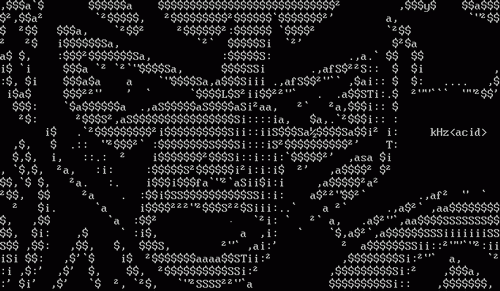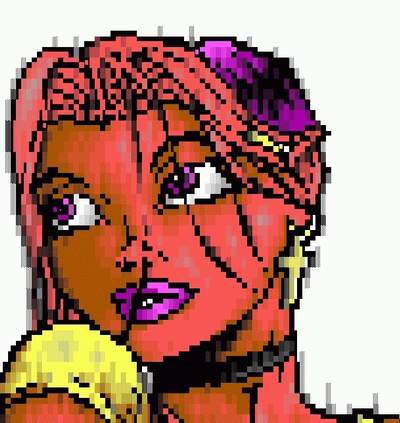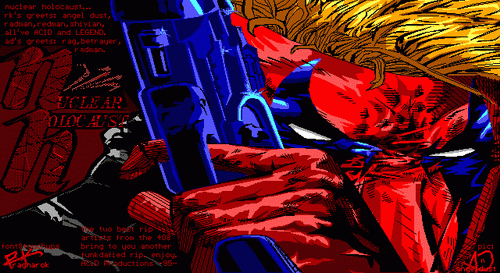ARTSCENE: INTRODUCTION by RaD Man, Shivan Bastard, Wildcat
INTRODUCTION
Ever since the days of the IBM PC 8088 and C64, personal computers
have been used for much more than word processing and data entry. Artists
around the world have found computer art to be less expensive and much less
restrictive than traditional paint and canvas. These artists have pioneered
many different electronic art mediums over the years, the most popular of
course being High-Resolution images and
Three-Dimensional Renderings. Primative mediums such as
ASCII and ANSI text, and
RIPscrip are still popular, but have moved far away
from the mainstream and into this little niche we call the digital
"ArtScene". These computer artists showcase their work via
virtual galleries on the web, through monthly collections (artpacks) of
their work with other artists, and by engaging in local and international
competitions such as 30-minute IRC compos and international demo parties like
Assembly, The Party, or NAID.

HISTORY
The artscene and its following has changed dramatically and grown
exponentially over the past decade. What started out as a small group of
friends sharing ANSIs on fido-net has expanded beyond their belief. The
early years were focused entirely on bulletin board systems.
Eventually, artists moved away from the FIDO-net and PD world, and
started forming their own underground elite networks. These were similar to
the FIDO-net style nets that connected bulletin boards running highly
customizable elite bbs software such as Oblivion/2 and Vision-X. People
would spend years tweaking out every aspect of their board, creating menu
modifications known as "mods", dozens of user selectable menu
templates, custom utilities, and so on. Click
here
for an ANSI animation that shows what a typical mod might do for your BBS
(Viewing with ACiD View 14400 or 28800 bps modem emulation recommended.) BBS's
remained the focus and medium of underground digital artists until 1995.
The internet really hit the center stage in 1994, and over the
next three years the entire scene has mosied it's way over to the
information superhighway. Yes, conventional dial-up artscene BBS's still do
exist today, but so does the 12" vinyl record and the 5.25 floppy disk.
So, let's carry on, SHALL WE? :)
Just about every major artscene group has a domain name and
spectacular web page. Many artists can be found on IRC channels such as
#ascii or #hirez on EF-Net, or #graphics and #art on Dalnet. In the past,
ANSI artists used to frequent EF-Net's #ANSI until mid 1995 when a bunch of
self-proclaimed "IRC hackers" took over the channel permanently
and made it their home (for reasons unbenounced to us.)
The art scene as I've described it has been primarily a
MS-DOS and Windows PC based scene. While some high-resolution (VGA) artists
have used Unix workstations, Apple Macintoshes, or Amiga computers to create
their art, the majority of the viewing audience has been almost completely
PC based. The internet is steadily changing that statistic, thanks to
technologies such as Sun's 100% Pure JAVA programming language which will
pave the way for universal Art Viewing programs and the like.

[ Top ]
ASCII
ASCII text art is by far the most limited of all computer mediums.
These images are created using the standard IBM extended 256-character set or
Amiga-X characters. Some artists opt to limit themselves from the proprietary
extended characters, taking advantage of only the core ASCII 128-character
set. By limiting themselves to ASCII's bare 128 characters, they gain
compatibility with virtually any terminals display without the need of any
sort of emulator whatsoever. Art created using the IBM or Amiga extended
character sets can only be viewed normally on their respective platform.
ASCII art was one of the first ways to display any kind of graphics
on a PC, and it will certainly be around for a long time to come. Even today
it is the only acceptable way to show a picture in certain situations; such
as in compressed archive comments, ftp .messages, IRC scripts, email
signatures, et cetera. Some people create ASCII art on their own, but the
vast majority join into groups and release their art in ASCII archives known
as "artpacks", "disks" or "collies" and others
choose to release their pieces with the other artwork inside regular artpacks.
Below is a small example of ASCII artwork. Note that the original ASCII
was over 200 lines, and only a small portion is displayed to preserve
space.


[ Top ]
ANSI
ANSI stands for American National Standards Institute. This
federation is responsible for facilitating development of national and
international standards. They play a role in standards of just about
everything, from airline safety to zirconium storage -- but most importantly
(to most of us any ways), terminal emulation!
If ANSI is involved with so many different standards, which one are
we talking about? Institute-wise, we are referring to ANSI's Advanced Data
Communication Control Procedure (ADCCP) X3.64-1979. But to the common computer
user ANSi means just one thing: A textmode medium which consists of the
standard IBM PC 256-character set, enhanced by 16 foreground colors, 8
background colors, and the ability to control and move the cursor. So,
from here on, ANSI X3.64-1979 = "ANSi".
Through a device driver (ANSI.SYS), ANSi allowed PC users to take
their plain old black and white communications software (Anyone remember the
original CROSSTALK?) and breath into it a whole new life! 16 colors, 8
background colors, even cursor movement! What would they think of next?
Through the ability to control the cursor, one could achieve the illusion of
animation on the screen.
ANSi artists are by far some of the most creative and resourceful
individuals in the entire 'scene. "ANSiMations", or ANSi-Movies
were popular in the late 80's and early 90's. These comic-like scenes
dashed across the screen with only 256 characters and 16 colors on 1200 and
2400 baud modems. Although it's original usefulness as a standard terminal
emulation for Bulletin Board Systems and remote system access has just about
diminished, its popularity as an artform continues to live on. Almost all
ANSI today is restricted to the artpacks that have been so dearly collected
for you on this site.
Since ANSi is made up of complicated escape sequences, special
editors have been created over the years that offer some truly incredible
features. Ian Davis' TheDraw(tm) was the pioneer of all ANSi editors,
and it's still used today for its powerful animation tools. However, more
advanced editors such as ACiD Productions'
ACiD Draw(tm)
and Sector Logic's
ArtWorx(tm)
have been developed.
Today, ANSi art has evolved to the point where it's no longer
practical to simply rely on your terminal to display them for you. Many
different viewers have been been developed that offer features such as
smooth scrolling, high-resolution vga mode viewing, and slide show options.
Some of the most widely used today are
ACiD View,
iCEView,
and DarkView. The examples below are just small portions of 200+ line ANSi masterpieces.


[ Top ]
RIPSCRIP
RIP stands for Remote Imaging Protocol. RIPscrip was developed by
Telegrafix in the early 90's with the intentions of giving dialup-BBS users
a choice of graphics, text, or both. Unfortunately, due to the hideously
proprietary nature in which their protocol was written, it failed miserably
and was not accepted by the masses as they had originally planned. However,
artscene members welcomed this poorly written protocol with open arms and
exploited it's limitations of 640x350x16 color EGA display and animation
possibilities. Unlike most of the art you see on web pages and such, RIP
is vector based, meaning that you see images being drawn in real time,
calculating geometric shapes, lines, fills and such rather than a simple
straight down binary copy in pixel maps. The only way to view RIP screens
is with a special viewer such as ACiD View. The best program to create these
types of screens is undoubtedly
Tombstone Artist.

3D DESIGN
3D modelling can be done through a variety of methods. One of the
most popular is raytracing. Raytracing is a method of creating incredible
photorealistic images on a computer. The first stage in creating a raytraced
image is to describe the scene. You can do this by using an expensive
interactive 3D modeler, or you can simply use a textfile with a complex
scene description syntax almost like a typical programming language. After
you've described the scene to your raytracer you have to wait for the
actual rendering to occur. This process can take anywhere from 30 seconds
to a couple of days depending on the complexity of your description and the
speed of your processor. The software mathematically models the lightrays
bouncing around your virtual world until they eventually reach the virtual
camera's position. This involves millions of floating point calculations and
until recently was limited only to Silicon Graphics workstations and other
powerful mini computers.
The most popular raytracer on the market, isn't! The Persistance
of Vision Raytracer (POV-Ray) is a complete freeware rendering package
available on many different platforms. The source code is also available
so you can feel free to customize it yourself or even add your own features.
It's not as user-friendly as some of the multi-thousand dollar commercial
packages out there, but it's definately a commercial grade raytracer. You
can learn more about POV-Ray from
http://www.povray.org,
and you can learn more about 3D Rendering in general from the
comp.graphics.rendering newsgroups. (Portions of this section taken from
the c.g.r.r FAQ.)
3D Studio is another popular, albeit very expensive 3D rendering
package. It uses a method called scanline rendering to create three
dimensional images in a fraction of the time a true ray tracer takes.
More information coming soon, for the time being visit
http://www.autodesk.com.


[ Top ]
HI-REZ
High resolution art, or Hirez for short, is one of the most popular
mediums in the scene today. Hirez encompasses everything from web graphics
to photomanipulation. However, a majority of hirez art is hand rendered,
executed in a comic book/toon style. The programs utilized to make hirez art
are as varied as the medium itself, yet two programs stand out for their
excellence and large following in the graphics community: Adobe Photoshop
and Meta Creations Painter. Both programs use natural media tools, such as
airbrushes, pencils, etc., to simulate the tools of the conventional artists.
However, "plugins", small third party programs intended to
"enhance" the original program, add a significant advantage over
paint and canvas. Effects such as glow, lighting, lens flares, and bevels
can easily be added with a click of the mouse. However, unlike many
"professional" graphicians, the scene has striven not to use the
plugins as a crutch.
Conventional artistic ability is paramount in hirez art, unlike
text-based forms such as ASCII and ANSI. Many elements of hirez art are
actually scanned in from more natural media, such as sketches or photographs.
Usually, these works are presented in full screen, 800x600 pixels, 16 million
colors. As seen, this medium offers few limits on the artist's creative
expression and therefore it is becoming one of the most popular vehicles
for artistic endeavors. Hirez art can be viewed in any web browser or in a
number of VGA capable viewers, including ACiD View. However, this visual
feast comes at a high price. To really enjoy Hirez art one must have the
system to do it justice. A good graphics setup includes a PCI SVGA video
card and a large monitor. Furthermore, the best "tools" for
viewing these works is a discriminating eye and an open mind. Beauty is
truly in the detail, and VGA is the only medium in the scene that allows
for this great amount of detail. It takes a talented artist to create it,
and a trained eye to appreciate it, but the results can be awe-inspiring.

Documentary by RaD Man, Shivan Bastard, and
Wildcat.
Copyright © 1997-1999 ACiD Productions, All Rights Reserved.>
[ Top ]
|

